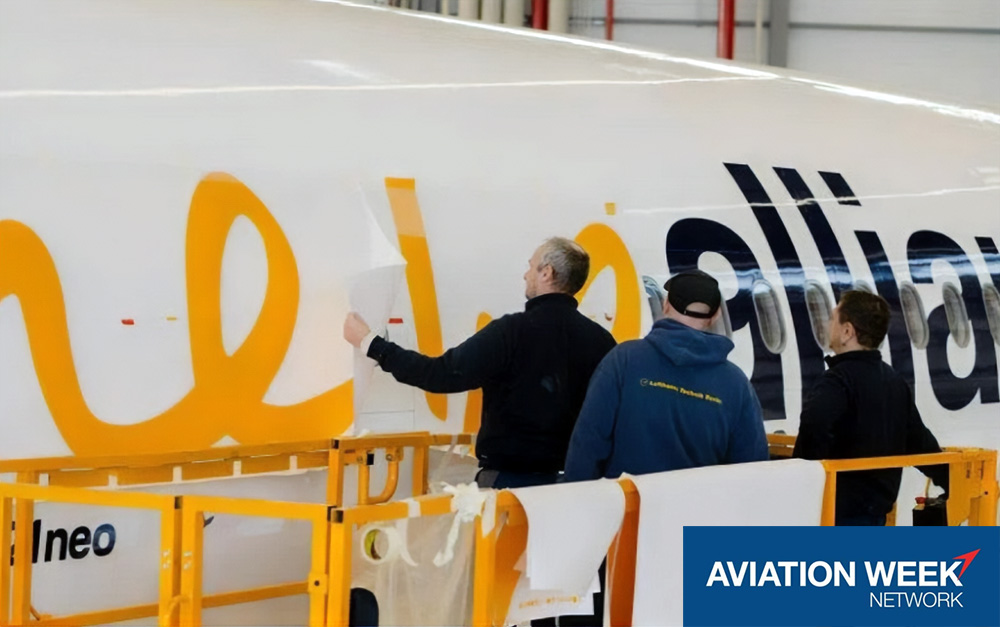Aviation Week recently explored the growing trend of aircraft graphics as an alternative to conventional paint, drawing on Tom Chatfield’s insights alongside other industry leaders.
In their comprehensive analysis published on 6 August 2025, Aviation Week’s Paul Seidenman and David Spanovich examine how airlines and operators are increasingly turning to custom-designed graphic applications for their aircraft liveries. The article, “Airlines Eye Graphics As Sustainable Alternative To Aircraft Paint“, provides a balanced view of this evolving market segment.
Tom Chatfield, our CEO, observed in the Aviation Week piece that there’s “a growing, albeit measured, trend in the aftermarket for high-quality graphic applications, particularly among corporate operators, charter and fractional ownership models.” Several factors are driving this shift:
Complex design capability – Where intricate liveries might prove prohibitively expensive or technically challenging to execute in paint, graphics offer a practical solution. These applications can achieve design complexity that would be difficult to replicate with traditional painting methods.
Cost efficiency for flexible branding – The ability to apply unique liveries or event-based designs quickly and reversibly represents a significant operational advantage, particularly for temporary or seasonal branding campaigns. This flexibility is increasingly valued by operators who need to adapt their aircraft appearance for specific events or partnerships.
Environmental considerations – Tom notes that “clients are increasingly mindful of the environmental impact of traditional painting and paint-stripping processes and are exploring graphics as a lower-emissions alternative.” Graphics produce fewer volatile organic compounds during application and generate less hazardous waste during removal.
Technical precision remains paramount – As Tom emphasised in the article, “there’s more to applying exterior graphics than simply slapping them on.” Graphics can only be applied after careful assessment of the surfaces on which they’re intended to be installed. As with conventional paint, applying graphics to an aircraft’s surfaces has inherent challenges where precision is paramount.
Key technical considerations include:
- Surface assessment: Careful evaluation of intended installation surfaces is essential
- Precision challenges: Complex curves, leading edges and engine nacelles present alignment and stretching risks
- Contamination control: Even minor surface contamination can compromise adhesion
- Operational limitations: Placement restrictions exist for areas that could affect flight controls, engine inlets or other critical systems
Digital modelling and template-guided installations have enhanced accuracy and fit, whilst modular panel-based graphics can simplify alignment and minimise on-site errors.
Industry perspectives – The Aviation Week article presents varying perspectives on market adoption. Whilst some industry players see limited applications primarily for short-term promotional campaigns, others observe expanding use cases where design complexity and application precision requirements favour graphics over paint.
The consensus suggests graphics serve specific applications particularly well—temporary branding, complex designs, and situations where downtime must be minimised. However, paint remains the preferred solution for long-term durability and certain operational environments.
Aviation Week Network – original article
The complete Aviation Week article includes perspectives from International Aerospace Coatings, MAAS Aviation, and Lufthansa Technik, offering a comprehensive view of the graphics market across different segments and geographical regions. The piece explores durability considerations, maintenance requirements, and evolving material technologies that continue to expand the possibilities for aircraft graphics applications.
For the complete industry analysis including perspectives from multiple MRO providers and detailed technical specifications, access the full Aviation Week article here.
(for reference only – displayed here with permission of Aviation Week)


